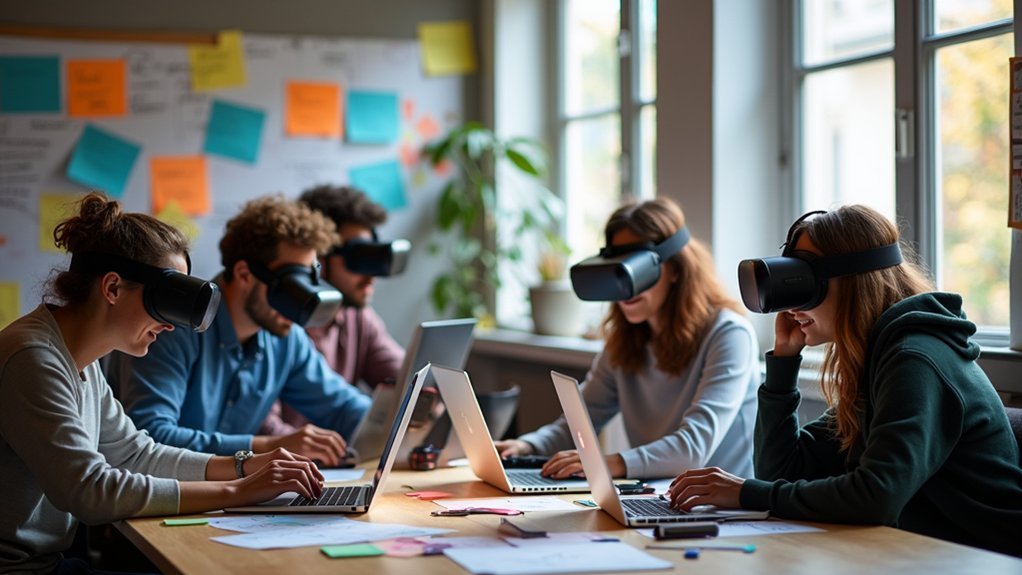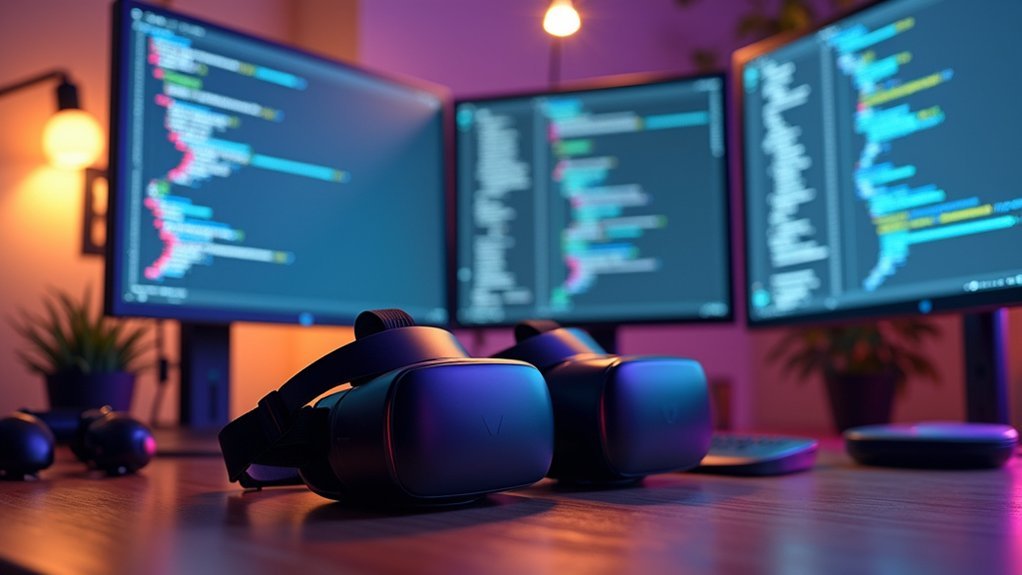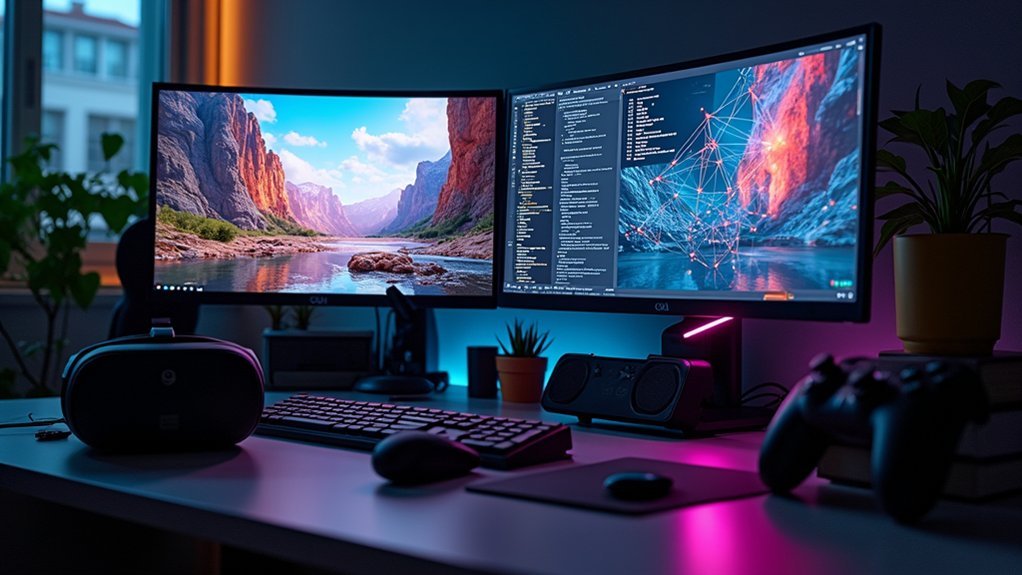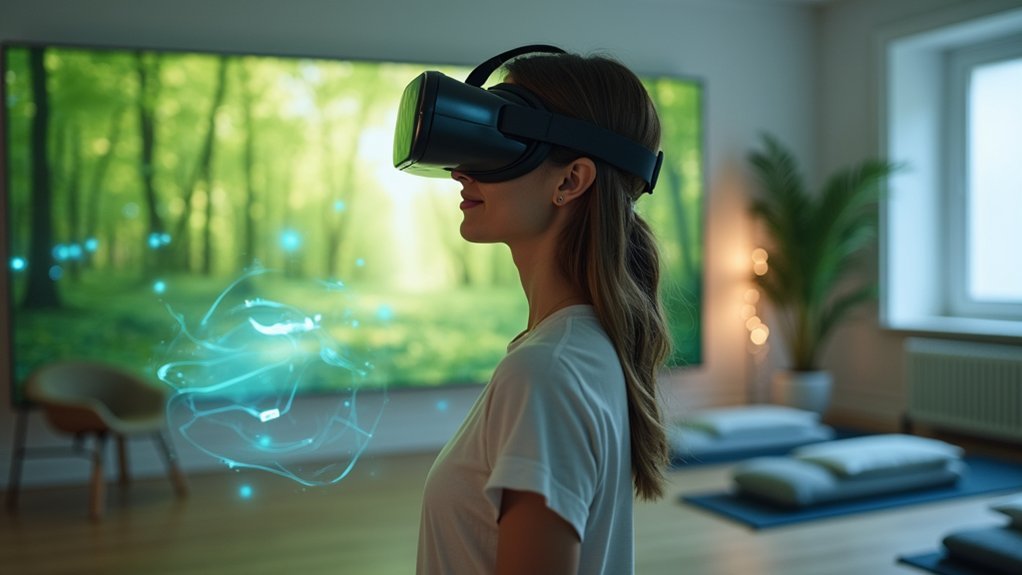You’ll find several excellent open-source platforms for immersive reality development that won’t break your budget. A-Frame offers HTML-like syntax for web-based VR experiences, while OpenXR SDK provides unified cross-platform compatibility across multiple devices. For Unity developers, UltimateXR delivers extensive VR framework support, and VR Builder enables drag-and-drop workflow creation without coding expertise. OSVR connects diverse hardware components through modular architecture, and WebXR Device API standardizes browser-based experiences. Each platform offers unique advantages that’ll match your specific project requirements and technical expertise.
Understanding Open Source Development Frameworks for Immersive Technologies

While traditional proprietary development tools often lock you into specific ecosystems, open-source frameworks for immersive technologies break down these barriers by giving you complete access to underlying source code.
You’ll find these development frameworks particularly valuable for VR and AR projects because they foster community-driven innovation that accelerates technological advancement.
When you choose open-source solutions, you’re tapping into collaborative environments where developers continuously improve tools and share knowledge.
Frameworks like OpenXR provide standardized APIs that guarantee interoperability across different hardware platforms, eliminating compatibility headaches you’d face with proprietary alternatives.
OpenXR’s standardized APIs ensure seamless compatibility across VR/AR hardware platforms, removing the integration challenges of proprietary development tools.
You’ll benefit from extensive documentation, user-friendly interfaces, and the ability to modify code according to your specific project requirements.
This flexibility enables rapid prototyping while greatly reducing development costs for your immersive technology ventures.
A-Frame: Web-Based Virtual Reality Creation Platform
You can build virtual reality experiences using A-Frame’s HTML-like syntax, which lets you create immersive 3D environments without learning complex programming languages.
The framework’s familiar web development approach means you’ll write VR scenes using tags and attributes similar to standard HTML markup.
A-Frame’s cross-platform compatibility guarantees your VR creations work seamlessly across various devices, from high-end VR headsets to mobile phones and web browsers.
HTML-Like VR Syntax
Although web developers traditionally faced steep learning curves when moving to VR development, A-Frame transforms this landscape by offering an HTML-like syntax that feels immediately familiar.
This open source web framework lets you create immersive VR experiences using tags and attributes you already know. You’ll write `
The HTML-like syntax means you can prototype quickly without learning entirely new programming languages. You’ll leverage your existing web development skills while accessing A-Frame’s rich component library.
Community contributions continuously expand these components, giving you pre-built elements for lighting, animation, and interaction. This approach democratizes VR development, enabling developers to focus on creativity rather than technical complexity when building immersive experiences.
Cross-Platform Device Compatibility
A-Frame’s web-based foundation delivers exceptional cross-platform compatibility that eliminates the traditional barriers between different VR ecosystems.
You’ll find this open-source framework seamlessly supports various VR headsets, mobile devices, and desktop browsers without requiring separate builds or installations. The WebVR API integration guarantees your immersive experiences work consistently across platforms, reaching broader audiences through standard web browsers.
Your interactive VR projects automatically adapt to different hardware configurations:
- Universal headset support – Works with Oculus, HTC Vive, PlayStation VR, and mobile headsets
- Browser-based deployment – No app store submissions or platform-specific distributions required
- Mobile responsiveness – Automatically adjusts for smartphone and tablet viewing
- Desktop compatibility – Functions on Windows, macOS, and Linux systems
- Community-driven device expansion – Community contributions continuously add support for emerging VR devices
OpenXR SDK: Cross-Platform VR Development Standard

When you’re developing VR applications for multiple platforms, the OpenXR SDK eliminates the frustrating cycle of rewriting code for each device. This open-source standard from the Khronos Group provides unified cross-platform compatibility, letting you create immersive experiences that run seamlessly across different VR headsets and operating systems like Windows, Android, and Linux.
You’ll access motion tracking, hand tracking, and environmental understanding through a single API, dramatically reducing your VR development time and effort. The SDK’s interoperability guarantees your applications work consistently across hardware without platform-specific modifications.
Community contributions from industry leaders continuously enhance OpenXR’s functionality, making it increasingly powerful for gaming, education, and training applications. This collaborative approach addresses real-world challenges while expanding capabilities for future immersive projects.
UltimateXR: Unity-Based Virtual Reality Toolkit
UltimateXR transforms Unity development by providing a detailed, open-source VR framework that eliminates the complexity of building immersive applications from scratch.
You’ll find this toolkit offers seamless cross-device support, ensuring your virtual reality projects work across major VR headsets and platforms without additional configuration headaches.
The framework’s extensive approach includes avatar customization tools that let you create personalized immersive experiences for users.
You’ll appreciate its compatibility with all Unity 3D rendering pipelines, making VR development more accessible regardless of your project’s technical requirements.
- Complete Unity integration with all rendering pipelines for maximum flexibility
- Cross-platform compatibility across major VR headsets and SDKs
- Built-in avatar customization system for personalized user experiences
- Extensive documentation and active community support
- Zero-cost, open-source framework reducing development barriers
VR Builder: Visual Scripting for Unity VR Development

While traditional VR development demands extensive programming expertise, VR Builder revolutionizes Unity-based virtual reality creation through its intuitive drag-and-drop workflow system. This free Unity plug-in enables you to craft immersive experiences without deep coding knowledge through visual scripting capabilities.
| Feature | Description |
|---|---|
| Platform Support | Meta Quest, HTC Vive compatibility |
| Core Workflow | Drag-and-drop visual scripting |
| Built-in Tools | Text-to-speech, teleportation setup |
| Target Industries | Education, construction, corporate training |
| Accessibility Level | Beginner-friendly interface |
VR Builder’s user-friendly design streamlines your development process across multiple VR platforms. You can design interactions through graphical interfaces, making it accessible for various industries seeking tailored VR solutions. Whether you’re developing educational content or corporate training modules, this toolkit simplifies Unity VR creation considerably.
OpenSpace 3D: Multi-Platform Interactive Environment Creator
Beyond Unity-focused solutions, OpenSpace 3D expands your creative possibilities by offering a thorough multi-platform environment for building interactive 3D experiences.
This open-source platform empowers you to design immersive experiences that deploy seamlessly across various VR hardware and software without extensive rework. You’ll benefit from its powerful game engine that enables intricate designs and rich interactivity tailored to your specific needs.
The platform’s Blender integration streamlines your design workflow, while community contributions foster collaborative development and continuous improvement of interactive 3D environments.
- Deploy VR experiences across multiple platforms with minimal adaptation required
- Leverage robust game engine capabilities for complex interactive designs
- Integrate seamlessly with Blender for enhanced 3D modeling workflows
- Access open-source flexibility encouraging customization and modification
- Contribute to collaborative community-driven development and feature expansion
Godot Engine: Game Development With Built-In VR Support
When you’re seeking an extensive game development solution with integrated VR capabilities, Godot Engine delivers a powerful, free platform that eliminates the complexity of adding virtual reality support as an afterthought.
This open-source engine supports major headsets including Oculus Rift, HTC Vive, and Windows Mixed Reality through its dedicated VR interface.
You’ll benefit from Godot Engine’s dual approach to development: visual scripting for beginners and GDScript for advanced programmers.
The platform handles stereoscopic rendering, motion tracking, and customizable user interfaces specifically designed for immersive VR interactions.
Whether you’re creating 2D or 3D experiences, Godot’s thorough game development tools streamline your workflow.
The thriving community provides extensive documentation and collaborative support, empowering you to build sophisticated VR applications efficiently.
OSVR: Open Source Virtual Reality Ecosystem
You’ll find OSVR’s modular platform architecture creates a unified framework that connects diverse VR hardware and software components through standardized interfaces.
The system’s hardware compatibility support spans multiple headset manufacturers and input devices, letting you develop once and deploy across various VR ecosystems.
OSVR’s developer integration tools include extensive APIs and plugins for major game engines, so you can build immersive experiences without getting locked into proprietary platforms.
OSVR Platform Architecture
Since OSVR (Open Source Virtual Reality) emerged as a thorough ecosystem rather than just another VR platform, its architecture fundamentally differs from proprietary solutions by prioritizing modularity and hardware agnosticism.
You’ll find that OSVR’s core server acts as a central hub, managing input and output from diverse VR devices while enabling seamless cross-platform experiences. The API gives developers direct access to low-level hardware functionalities, letting you optimize performance for specific immersive applications.
This open-source approach means you can integrate new hardware without extensive reconfiguration.
- Modular design enables easy addition and updates of hardware support
- Core server manages all device communications and data flow
- Hardware-agnostic framework supports various headsets, sensors, and input devices
- Comprehensive API provides low-level access for performance optimization
- Cross-platform compatibility guarantees applications work across different virtual reality systems
Hardware Compatibility Support
Because OSVR’s open architecture removes vendor lock-in constraints, you can deploy applications across an extensive range of VR hardware without rewriting code for each device.
The platform’s hardware compatibility extends to headsets, motion controllers, and tracking systems from multiple manufacturers, creating a unified immersive reality ecosystem.
You’ll benefit from OSVR’s thorough APIs and SDKs that streamline integration with diverse VR hardware configurations.
The modular design enables seamless addition of new drivers as emerging technologies enter the market, ensuring your applications remain current with evolving hardware standards.
Through community involvement, developers continuously enhance software compatibility by contributing drivers and optimizations.
This collaborative approach accelerates support for new devices while maintaining stability across existing hardware, making OSVR an ideal foundation for cross-platform immersive reality development.
Developer Integration Tools
When integrating OSVR into your development workflow, you’ll find extensive toolsets that accelerate VR application creation across multiple platforms. This open-source ecosystem provides seamless integration tools that connect directly with Unity and Unreal Engine, eliminating compatibility barriers.
You’ll access thorough plugins and drivers that streamline your VR development process, allowing you to focus on creating immersive experiences rather than wrestling with hardware limitations.
- Universal SDK compatibility – Connect with multiple VR headsets and peripherals through standardized APIs
- Game engine plugins – Pre-built integrations for Unity, Unreal Engine, and other development environments
- Community-driven resources – Leverage shared tools, documentation, and code libraries from active developers
- Cross-platform deployment – Build once and deploy across different VR hardware ecosystems
- Real-time debugging tools – Monitor performance and troubleshoot issues during development cycles
Community collaboration guarantees continuous improvement and expanding functionality.
WebXR Device API: Browser-Based Immersive Experiences
As web browsers evolve into powerful platforms for immersive experiences, the WebXR Device API stands at the forefront of this transformation, offering developers a standardized pathway to create virtual and augmented reality applications that run directly in users’ browsers.
You can build cross-platform applications using familiar web technologies like HTML, CSS, and JavaScript. The API supports 3D rendering, spatial tracking, and real-time interactions across desktops, smartphones, and VR headsets without requiring additional software installations.
| Feature | Capability | Browser Support |
|---|---|---|
| VR Support | Full headset integration | Chrome, Firefox |
| AR Support | Mobile camera overlay | Chrome, Firefox |
| 3D Rendering | WebGL-based graphics | Chrome, Firefox |
| Spatial Tracking | Head/hand movement | Chrome, Firefox |
| Cross-Platform | Universal device compatibility | Chrome, Firefox |
Your immersive experiences become instantly shareable through standard web links.
Blender VR Scene Inspection: 3D Modeling and VR Integration
The intersection of 3D modeling and virtual reality reaches new heights through Blender’s VR scene inspection capabilities, transforming how you visualize and refine your creative projects.
This free, open-source software bridges traditional 3D modeling with immersive environments, enabling you to step inside your creations using compatible VR headsets.
Blender’s extensive toolset supports VR integration through advanced sculpting, texturing, and animation features.
You’ll export models seamlessly to major VR development platforms like Unity and Unreal Engine, streamlining your workflow from conception to deployment.
- Real-time VR visualization allows immediate feedback during the creative process
- Compatible export formats support all major VR development environments
- Advanced sculpting tools create detailed assets optimized for immersive experiences
- Community contributions expand functionality through specialized VR plugins
- Integrated rendering pipelines deliver high-quality visual output for VR applications
Evaluating Open Source Platforms for Your VR Project Needs
How do you determine which open-source platform will best serve your VR project’s unique requirements? Start by evaluating SDKs like A-Frame and UltimateXR for ease of use, device compatibility, and community support.
Consider platforms such as OpenXR that offer standardized approaches, allowing developers to write code once and deploy across multiple immersive reality devices.
Your choice of development engine greatly impacts project outcomes. Unity’s extensive documentation and active community make it developer-friendly, while Unreal Engine delivers high-fidelity graphics for demanding VR projects.
You’ll also need to assess technical requirements, including programming languages like C++, C#, and Python, ensuring your team’s skills align with platform demands.
Remember that community collaboration drives open-source platform success. Active contributors improve features, fix bugs, and share valuable insights that enhance your development experience.
Frequently Asked Questions
What Is the Best Platform to Make a VR Game?
You’ll find Unity’s your best bet for VR game development. It’s beginner-friendly, supports multiple headsets, and offers extensive assets. If you’re targeting high-end graphics, consider Unreal Engine instead.
Is Fully Immersive Virtual Reality Possible?
Yes, you’ll experience fully immersive VR through today’s advanced headsets with high-resolution displays, spatial audio, and haptic feedback. AI integration and precise motion tracking create convincing virtual environments you can’t distinguish from reality.
What Software Is Used to Create Virtual Reality?
You can create virtual reality experiences using Unity for game development, A-Frame for web-based VR, Unreal Engine for high-quality graphics, or Blender for 3D modeling and animation assets.
What Software Is Used for Augmented Reality?
You’ll use ARCore for Android apps, ARKit for iOS development, Vuforia for cross-platform computer vision experiences, MetaSpark Studio for social AR filters, or ARToolKit for open-source geometric registration projects.





Leave a Reply